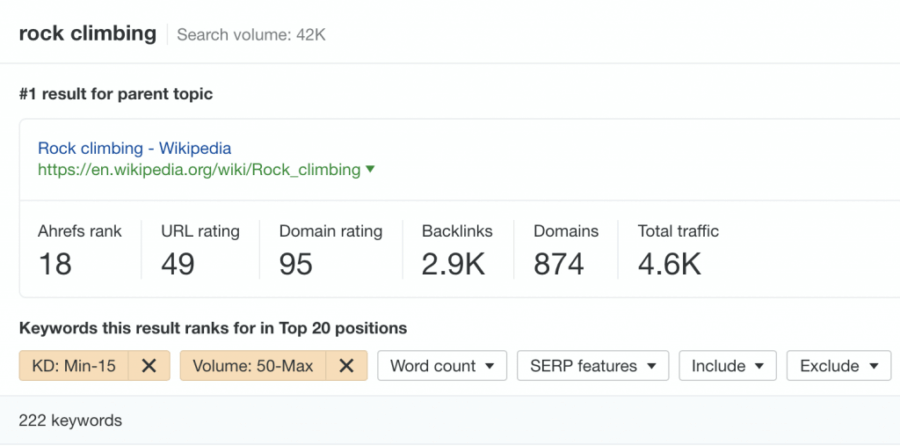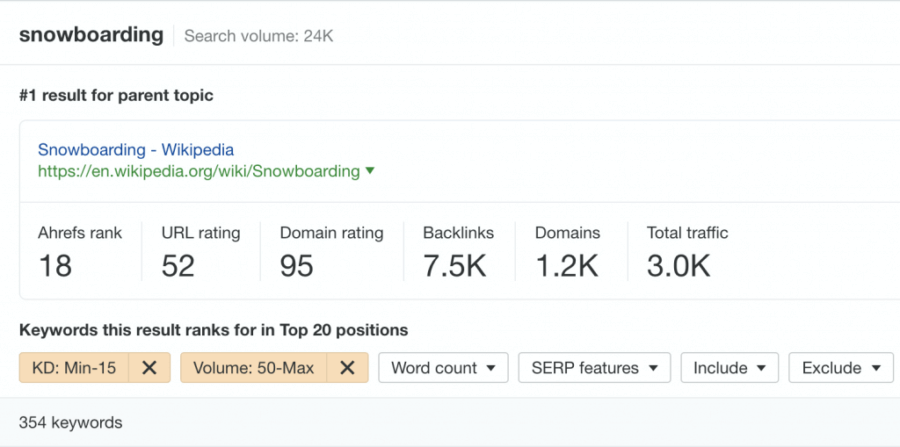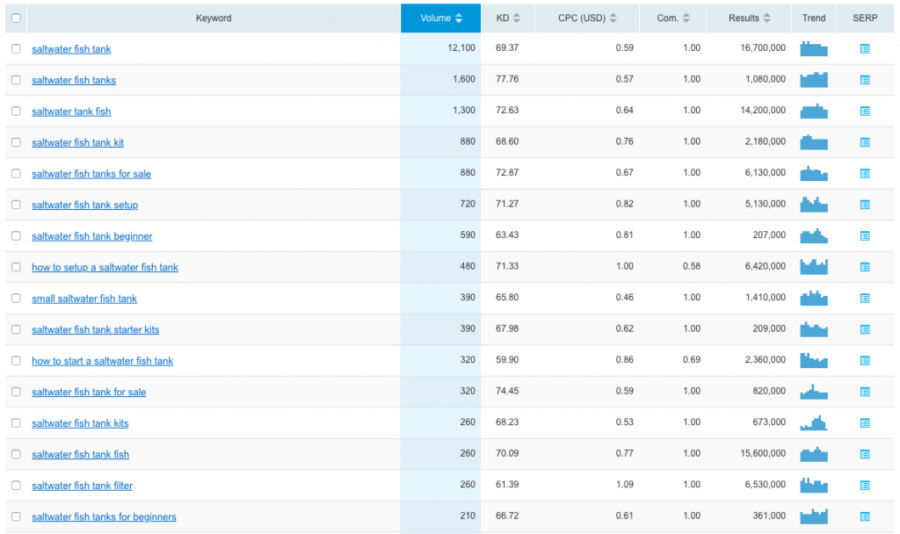A data-driven approach to finding a niche for your blog so you can rank higher in Google search results.
So you’ve decided to start a new blog. That’s a great idea!
Blogging is a great way to increase organic search traffic to your website. Frequently publishing awesome content provides more opportunities to provide value to your potential clients (and more opportunities to rank in search results when those clients are actively searching for your content).
It’s also one of the best ways to build trust and authority for your brand. If you are consistently providing value to your readers, they will start to see you as a trustworthy source. This trust can only be built if you are producing quality blog content. Spammy blogs or frequent sales pitches are a sure-fire way to lose credibility.
But you can’t just blog about anything.
The most successful blogs in the world target a specific niche. If you aren’t familiar with this oft-confusing to pronounce term, a niche is a topic that is devoted to a specialized interest.
This post will dive into why finding a niche is important for your blogging efforts and how you can get started. We’ll also discuss some data-driven methods you can use to measure the viability of your blog niche.
Why Finding a Niche is Important
A simple google search for “awesome blog ideas” comes back with 39,900,000 results. We clicked all the way back to the 20th page of the search results (I might be the first person in the history of the world to do this) and there were still relevant results of pages that look like they are targeting that exact keyword! And that is only the 20th page, there are still hundreds of more pages of results for that search.
Finding a niche reduces your competition and makes it easier to rank for relevant keywords. So instead of trying to rank for “awesome blog ideas” you can try to rank for less competitive keywords such as “saltwater fish tanks starter kit” (776,000 results).
Remaining in a niche is also important because readers will learn to look to you for answers on a specific topic. If you are writing about anything under the sun, your readers will become confused because you don’t have a specialization. Furthermore, it’s hard enough to gain credibility and expertise in a single niche. Being an “expert” on dozens of things is basically impossible.
Where to Start
Start with an initial “brain dump” of blog topic ideas. List everything you are interested in, everything you’ve ever wanted to be interested in, everything you used to be interested in. These are potential niches.
We start by pooling together a list of all of those broad topics. We then head over to Ahrefs and plug each of those into their keyword explorer tool.

From there, we click on the “Parent Topic” for each of those themes individually to get a quick read on the search queries that we could write about (NOTE: this will show the full list of keywords that the #1 result on Google ranks for. It’s not a catch-all, but rather, an introduction to the opportunity that exists).
One by one, we narrow down the total list of “eligible” topics to write about for each industry. Historically, we’ve narrowed our initial list of each parent category to only show keywords with a search volume of 50 or greater and a keyword difficulty of 15 or less.

In the case of rock climbing, we see 222 keywords remain after this filtering. Snowboarding, on the other hand, has 354 keywords remaining.

We then repeat this for every other theme that we identified to narrow down on the best opportunities.
Once we’ve come up with a few great options, we go through another round of narrowing down. This time, we may eliminate keywords with less than 200 searches/month and a keyword difficulty score above 10 until we have 1-2 clear winners.
If you’re blogging for business, it makes sense to pick a niche related to your product or service. We know what you’re thinking, “There is no way I can find enough to write about. And my business is boring.”
Well, kind reader, you’re wrong. Your business is not boring.
Every industry requires unique insider knowledge. Use your blog to teach the world about the cool things that only people in the garage door industry know about.
Growing up, I had soccer practice right next to a large garage door manufacturer. I was always so curious about what was going on in there. Especially when they had these doors going up and down, up and down, for hours on end. Turns out, they were doing product testing and quality assurance. That could be a blog post right there.
Let people see “behind the scenes” of your so-called “boring” business. That could be your niche — a behind-the-scenes look at how garage doors are made. You could walk readers through every step of the process, like that old Discovery Channel show “How it’s Made.” Side Note: Apparently “How it’s Made” did do a garage door episode and it has over 30,000 views on YouTube!
Turns out, garage doors aren’t so boring after all. And judging by the number of views on that video, there is an audience out there as well.

In this niche, you could write about all things garage-related. Like how to soundproof your garage for band practice, how to paint an old garage door, maintaining a wooden garage door, how to decorate your garage for Halloween etc.. And that’s just a start. At Inter, we utilize half-a-dozen methods for coming up with interesting and engaging blog topics, regardless of how “boring” a niche is.
Related: The 4 Components of a Top-Tier Content Strategy
How to Analyze Search Volume
Now that you have a list of potential niches, see if people are actually searching for topics within that niche.
Analyzing search volume is a good way to gauge the size of your target audience. Without a decent search volume, you’ll have a very hard time attracting readers.
There are a ton of tools to analyze search volume. You can use the free Google Keyword Planner, but for more in-depth analysis we use SEMRush and Ahrefs.
Here’s a look at the search volume for “saltwater fish tanks” and related keywords.

As you can see, there are a lot of searches for the exact match keyword (“saltwater fish tanks”). You’ll also notice there is decent search traffic for long-tail keywords which could make for some great blog post, like “How to Start a Saltwater Fish Tank” or “Saltwater Fish Tanks for Beginners.”
You’ll want to look for a niche with a large number of monthly searches. This essentially means your potential audience is large.
How many searches should you be looking for?
That really depends on a variety of factors, including competition. But as a general rule, we suggest focusing on a niche with 10,000+ searches a month, with related searches (a.k.a. potential blog topics) within that niche at 300+ searches a month.
The saltwater fish tank doesn’t appear to be an amazing example of an ideal niche for a few reasons. The first thing we noticed right off the bat is that the Keyword Difficulty (KD) is relatively high – this is a SEMRush metric indicating how hard it might be to rank high for that keyword. Also, the Competitive Density (Com.) is “1.00” for most of these keywords – meaning that a lot of advertisers are paying to show up in the search results. This means that there are a lot of people willing to spend money to appear higher than you on the SERPs.
But we’re getting a little ahead of ourselves. The bottom line here is that you should make sure people are searching for your niche before getting started.
Now let’s take a closer look at how the competitors in this niche.
Related: avoid these 7 content marketing mistakes at all costs.
How to Review Competitor Strength
Once you’ve narrowed down your list to topics people are actually searching for, it’s time to analyze the competition. If you have dreams of ranking on the first page of Google, you’re going to have to be better than thousands of other sites.
How can you tell if that’s a reasonable aspiration? Look at your competitor’s Domain Authority or Domain Rating.
Domain Authority is a metric developed by Moz, while Domain Rating is Ahrefs’ proprietary metric. They vary slightly on how they are calculated but the idea is the same.
Both scores attempt to rate how strong a website is seen in the eyes of Google.
The score is developed mainly by looking at a website’s backlink profile (how many websites are linking to it). A strong backlink profile means that a lot of sites are linking to a website, meaning that a lot of people on the internet trust that site.
Going back to the saltwater topic from earlier, we did a search for “saltwater fish tanks” to see if there are any other blogs out there covering this topic. We used the Ahrefs Chrome extension that shows a website’s domain rating directly on the SERPs.
There were quite a few shopping ads and YouTube videos. The top 3 results were pet supply stores with super high domain ratings. The next 3 results were blog posts by PetCo, PetMD, and Earthsfriends.com – also sites with high domain ratings.
It wasn’t until the 7th result that we found a blog dedicated to saltwater fish tanks: http://www.saltwatersmarts.com/. We went to the 2nd and 3rd pages of Google results and didn’t find any other blogs focusing on this topic, only more fish tank stores trying to sell us something.
The people behind Saltwater Smarts have seemed to have found a niche. It is a very competitive space. And the search results are currently being dominated by products, but they seem to stand alone in the space of providing information and help regarding saltwater fish tanks. Unlike the other results on Google, this was the only one that was focused on the informative content in the saltwater fish tanks niche. They are also the only site we found that wasn’t trying to sell us something.
We were curious to see how the site was performing, so we plugged it into Ahrefs site explorer tool. This is what we found.

This site has obtained a huge backlink profile and currently ranks for over 16,000 keywords! We checked on some of their keywords and they are in the #1 position for over 100 keywords, ranging in search volume from 10 to 1,400 searches a month. That’s a lot of potential traffic.
Despite the high keyword difficulty and competition, you can still be successful if you are matching a different search intent. In this example, all of Saltwater Smarts competitors are trying to attract searchers looking to buy; while Saltwater Smarts is attracting searchers looking to learn.

Saltwater Smarts identified a niche they are obviously very knowledgeable about. The niche also has a high search volume, but relatively little competition. Their main competitors are retailers, meaning that if a searcher’s intent is information focused and not purchasing focused, they have a good chance of capturing that click.
It’s a thing of beauty, really.
The rankings and backlink profile of Saltwater Smarts are what you should aspire to mimic. They built up a huge backlink profile by providing useful information, as opposed to pushing products. Keep in mind, this site has been in this niche for a long time and they’ve obviously put in a ton of work.
And full disclosure: we have no relationship with this site. And we don’t have any interest in saltwater fish tanks. Not that it’s wrong if you do…
If you need some help identifying a niche for your blog, or if you’re a garage door company running short on blog post ideas, send us a message or ask us a question on Twitter. We love talking content strategy and would be more than happy to chat.
SCALE YOUR ORGANIC TRAFFIC
Subscribe to our monthly newsletter



